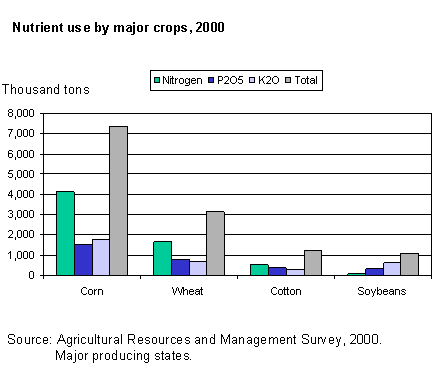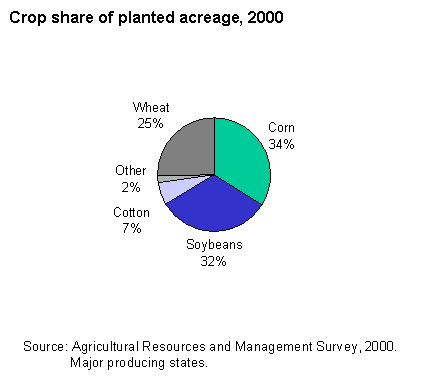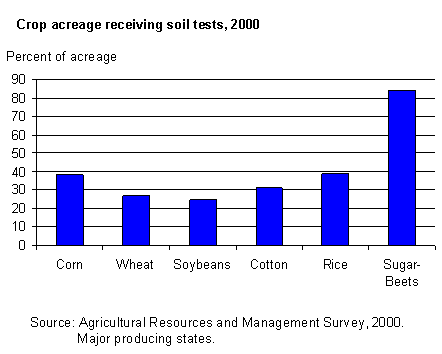|
|
|
|
 |
 |
agricultural chemicals and production technology: questions and answers |
Q. What major crops receive the most fertilizer?
A. Corn continues as the dominant user of commercial fertilizers
(N, P2O5, K2O) in 2000, followed by wheat, cotton, and soybeans,
based on the 2000 Agricultural Resources
and Management Survey (ARMS). The ARMS survey for 2000 crops
covers the major producing States, including 11 corn, 13 soybean,
8 upland cotton, 5 spring wheat, 16 winter wheat, and 11 sugar-beet
States.

Corn, soybeans, wheat, and cotton were planted
on 98 percent of the cropland represented in the 2000 ARMS survey.
Corn is the major cropland user, followed closely by soybeans.

Fertilizer application rates were relatively unchanged from those
of 1999, but fertilized acres declined, resulting in slightly
reduced total fertilizer use in 2000. Data on 2000
fertilizer use and practices are available for individually
surveyed States.
Corn was the largest user of nitrogen, phosphate, and potash
fertilizers, followed by wheat, soybeans, and cotton.
- Nitrogen was applied to 98 percent of 61.2 million planted
corn acres in major producing States, fertilized with an average
application rate of 137 pounds per acre.
- Nitrogen application rates for corn in the 1990s were lower
than in the 1980s, but have increased in 2000.
- Phosphate was applied to 85 percent of corn acres fertilized,
with an average application rate of 58 pounds per acre. Phosphate
application rates for corn have declined slightly since 1980.
- Potash was applied to 69 percent of corn acres fertilized
in 2001, with an average application rate of 83 pounds per acre.
Potash application rates for corn ranged around 80 pounds per
acre since 1980.
- Nitrogen, phosphate, and potash application rates vary substantially
among corn producing States.
Highlights of common nutrient management practices on major
field crops in 2000
The most common time to apply fertilizer to corn and soybeans
continues to be spring, before planting. For other crops, the
most comon times for fertilization are:
- At planting for durum and spring wheat
- After planting for upland cotton
- Fall/before planting for winter wheat and sugarbeets.
Ground broadcast continued to be the principal method of fertilizer
application on the major crops, followed by banding and injection.
Soil testing for fertilizer needs ranged from 84 percent of acres
for sugarbeets to 25 percent for all soybeans. Most acres were
tested for nitrogen.
-
Total nutrient use was down about 2 percent in 1999 compared
to 1998 with nitrogen use up 1 percent, phosphate use down
6, and potash use down 5 percent.
-
Acreage planted to corn and wheat, the two crops using the
most fertilizer, was less than in 1998, while acreage planted
to soybeans and cotton was up. Corn used 40 - 45 percent of
all fertilizer.
-
Application rates varied by crop when compared to 1998. For
corn, the annual nitrogen application rate was up a pound,
phosphate the same, and potash down 2 pounds.
-
On soybeans, application rates were down for all nutrients.
-
On cotton, rates were up for all nutrients.
-
Only one wheat-producing State was surveyed, so comparisons
to 1998 were not done.
-
Potatoes received the highest annual application rates per
acre for field crops, with nitrogen averaging 222 pounds,
phosphate 176 pounds, and potash 167 pounds.
-
Most fertilizer was applied in 1999 at or before planting
on field crops.
-
Review of 1998 nutrient use and practices on major crops
-
Total nutrient use was less than 1 percent lower in 1998
than in 1997, with nitrogen and phosphate use about the same
time, and potash use down about 2 percent.
-
The major factor decreasing nutrient use in 1998 was lower
fertilized wheat acreage, which used about 14 percent of all
fertilizer.
-
Nitrogen and phosphate application rates on wheat were about
the same in 1998 as in 1997, but potash application rates
were less.
-
Corn acreage, which used 40 to 45 percent of all fertilizer,
was about the same in 1998 as in 1997.
-
for more information, contact:
Wen Huang
web administration: webadmin@ers.usda.gov
page updated:
November 12, 2002
|
|


